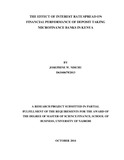| dc.description.abstract | MFIs over the past have primarily focused on micro lending activity and ignored savings
deposits, therefore deposit taking microfinance bank (DTMB) business can be called a
venture still in its determining stages. The Microfinance Act which became operational
on 2nd May 2008 saw most of the micro-finance institutions apply for licenses to allow
them to take deposits in Kenya after year 2009. DTMBs have demonstrated a good
outreach especially in the rural areas with improved financial performance and have
managed to reach close to a third of clients who were previously excluded from financial
access. This calls for special attention by government towards this business. DTMBs
need to be effective, efficient and competitive in their operations. Interest rates spread, as
sensitive variable influencing financial performance, ought to be adequately harmonized
so that savers have the assurance that they are getting the best returns on their savings and
that borrowers are getting rates appropriate to their investments. The main objective of
the study was to establish the effect of interest rate spread and on the financial
performance of DTMBs in Kenya. Additionally, the researcher wanted to ascertain the
influence of other industry specific variables and macro-economic environment on
DTMBs financial performance. The research study utilized descriptive research design
and embraced systematic random sampling technique on selecting the four DTMBs in
Kenya out of the nine existing in the country. Secondary data were analyzed and
presented inform of tables and figures to provide a clear picture of how interest rates
spread contribute in the success or failure of the DTMB business and to show the various
characteristics and relationships among the variables in consideration. Findings showed
that interest rate spread is statistically significant at 95% and 99% significant level with a
negative correlation thus as IRS increases the financial performance of DTMBs
decreases. The other controlling market (industry) specific and macro-economic
environment variables, that is, leverage, non performing loans, liquidity ratio and GDP
per capita annual growth in % ratio showed a statistically significant positive correlation
hence play a major role in positively influencing the performance of micro-banking
industry and are therefore important for DTMB business to operate as a going-concern in
the foreseeable future. It is evident from the research findings that the interest rate spread
provided sufficient margins for microfinance banks to continue operating in the market.
In conclusion, the study found out that interest rates spread negatively affect the financial
performance of DTMBs in Kenya. The researcher therefore, recommended to the microfinance
banks’ management to be both proactive and reactive in harmonizing interest
rates spread in order to cushion their institutions from any financial shocks that could be
experienced in the micro-banking industry in Kenya. Lastly, it is of great importance for
the DTMBs to pay great attention to credit risk when evaluating customers’ loan
proposals due to the fact that a large chunk of banks’ revenue accrues from loans from
which interest income is derived. | en_US |

